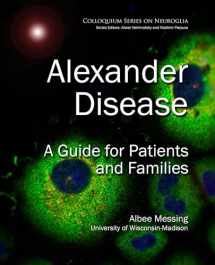
Alexander Disease: A Guide for Patients and Families (Colloquium Neuroglia in Biology and Medicine: From Physiology to Disease)
ISBN-13:
9781615047581
ISBN-10:
1615047581
Author:
Alexei Verkhratsky, Albee Messing, Vladimir Parpura
Publication date:
2017
Publisher:
Morgan & Claypool
Format:
Paperback
96 pages
Category:
Biology
,
Biological Sciences
FREE US shipping
Book details
ISBN-13:
9781615047581
ISBN-10:
1615047581
Author:
Alexei Verkhratsky, Albee Messing, Vladimir Parpura
Publication date:
2017
Publisher:
Morgan & Claypool
Format:
Paperback
96 pages
Category:
Biology
,
Biological Sciences
Summary
Alexander Disease: A Guide for Patients and Families (Colloquium Neuroglia in Biology and Medicine: From Physiology to Disease) (ISBN-13: 9781615047581 and ISBN-10: 1615047581), written by authors
Alexei Verkhratsky, Albee Messing, Vladimir Parpura, was published by Morgan & Claypool in 2017.
With an overall rating of 3.7 stars, it's a notable title among other
Biology
(Biological Sciences) books. You can easily purchase or rent Alexander Disease: A Guide for Patients and Families (Colloquium Neuroglia in Biology and Medicine: From Physiology to Disease) (Paperback) from BooksRun,
along with many other new and used
Biology
books
and textbooks.
And, if you're looking to sell your copy, our current buyback offer is $0.3.
Description
This book offers a comprehensive overview of Alexander disease, a rare and devastating neurological disorder that often affects the white matter of the brain and spinal cord. Its distinctive neuropathology consists of abundant Rosenthal fibers within astrocytes (one of the four major cell types of the central nervous system). Nearly all cases are caused by variants in the gene encoding the intermediate filament protein GFAP, but how these changes in GFAP lead to the widespread manifestations of disease is poorly understood. Astrocytes, while discovered over a century ago, are themselves still much of a mystery. They exhibit considerable diversity, defy precise definition, and yet actively regulate many aspects of nervous system functioning. We also have incomplete understanding of Rosenthal fibers, odd structures that contain GFAP as just one of many components. Whether they are toxic or protective is unknown. Moreover, Rosenthal fibers are not absolutely unique to Alexander disease, and are seen sporadically in a wide variety of other conditions, including brain tumors and multiple sclerosis. GFAP is the third unknown. It is an ancient protein, arising early in the evolution of vertebrates, but its role in normal biology is still a matter of debate. Yet Alexander disease shows, without a doubt, that changing just a single of its 432 amino acids can lead to catastrophe, not just in the astrocytes where GFAP is produced but also in the other cells with which astrocytes interact. Despite all of the unknowns, much has been learned in the past 20 years, and it is time to share this knowledge. This book is intended for recently diagnosed patients and families, as well as non-specialist researchers interested in this neurological disease. It covers historical origins, the state of current knowledge, and prospects for what lies ahead, with citations to the primary literature given throughout.


We would LOVE it if you could help us and other readers by reviewing the book
Book review

Congratulations! We have received your book review.
{user}
{createdAt}
by {truncated_author}


